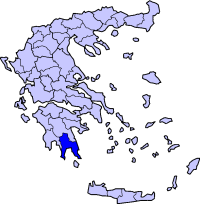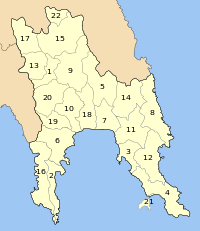Laconia
- For the ancient region, see Laconia (ancient region) and Sparta
- Lakonia redirects here. For the vessel, see TSMS Lakonia.
| Laconia Prefecture Νομός Λακωνίας |
|
|---|---|
 |
|

|
|
| Country: | |
| Capital: | Sparti |
| Periphery: | Peloponnese |
| Population: | 100,871 (2005) Ranked 37th |
| Area: | 3,636 km² (1,404 sq.mi.) Ranked 10th |
| Density: | 28 /km² (72 /sq.mi.) Ranked 50th |
| Number of municipalities: | 20 |
| Number of communities: | 2 |
| Postal codes: | 23x xx |
| Area codes: | 273x0 |
| Licence plate code: | ΑΚ |
| ISO 3166-2 code: | GR-16 |
Laconia (Λακωνία), also known as Lacedaemonia, is a prefecture of Greece. Its administrative capital is Sparti (Sparta) and its main towns and cities are Amykles, Areopoli, Gytheio, Molaoi, Monemvasia, Mystras, Voies and Oinountas. It encompasses Cape Malea and Cape Tainaron and a large part of the Mani Peninsula.
Contents |
Geography
It is bounded by the Taygetus mountains to the west with Messenia, Arcadia to the north and with the Parnon mountains to the northeast, the Myrtoan Sea to the east and the Gulf of Laconia and the Mediterranean Sea to the south. The islands of Cythera and Antikythera lie to the south, but they administratively belong to the prefecture of Piraeus.
The Evrotas is the longest river in the prefecture. The valley of the Evrotas is predominantly an agricultural region that contains many citrus groves, olive groves and pasture lands and most of all, oranges. It is the location of the largest orange production in the Peloponnese and probably all of Greece. The brand of orange juice named after this prefecture Lakonia is based in Amyclae and sells fresh orange juice entirely from this region.
Taygetus (2,407 m), known as Pentadaktylos (five-fingers) throughout the Middle Ages, is west of Sparta and the Evrotas valley. It is the highest mountain in Laconia and the Peloponnese, and mostly covered with pine trees. Two roads connect the adjoining prefectures of Messinia and Laconia: one is a tortuous mountain pass through Taygetus and the other bypasses the mountain via the Mani district to the south. The other major mountain is Parnon (1,961 m) to the east.
A stalactite cave in the southwest of the prefecture is located south of Areopolis. This famous cave is called Dirou and is a major tourist attraction.
The word "laconic" is derived from the name of the region by analogy - to speak in a concise way, as the Spartans were reputed by the Athenians to do.
Climate
Snow is very common throughout the winter.
Provinces
- Epidavros Limira Province - Molai
- Gytheio Province - Gytheio
- Lacedaemonia Province - Sparti
- Oitylo Province - Areopoli
Note: Provinces no longer hold any legal status in Greece.
Municipalities and communities
| Map | Municipality | Municipal code | Seat (if different) | Postal code |
|---|---|---|---|---|
| 3 | Asopos | 3202 | Papadianika | 230 56 |
| 2 | East Mani | 3201 | Kotronas | 230 66 |
| 7 | Elos | 3207 | Vlachiotis | 230 55 |
| 20 | Faris | 3222 | Xirokampi | 230 54 |
| 5 | Geronthres | 3204 | Geraki | 230 58 |
| 6 | Gytheio | 3205 | 232 00 | |
| 10 | Krokees | 3211 | 230 57 | |
| 11 | Molaoi | 3212 | 230 52 | |
| 12 | Monemvassia | 3213 | 230 70 | |
| 13 | Mystras | 3214 | Magoula | 231 00 |
| 14 | Niata | 3215 | Agios Dimitrios | 230 60 |
| 15 | Oinountas | 3216 | Sellasia | 230 64 |
| 16 | Oitylo | 3217 | Areopoli | 230 62 |
| 17 | Pellana | 3218 | Kastoreio | 230 59 |
| 18 | Skala | 3219 | 230 51 | |
| 19 | Smynos | 3220 | Agios Nikolaos | 230 61 |
| 1 | Sparti | 3221 | 231 00 | |
| 9 | Therapnes | 3209 | Gkoritsa | 231 00 |
| 4 | Voies | 3203 | Neapoli | 230 53 |
| 8 | Zarakas | 3208 | Reichea | 230 68 |
| Community | Municipal code | Seat (if different) | Postal code | |
| 21 | Elafonisos | 3206 | 230 53 | |
| 22 | Karyes | 3210 | 230 67 |
Population
- 1907: 87,106
- 1991: 95,696 (+8,590 or +9.862% from 1907)
- 2001: 94,918 (-778 or -0.81%)
History
Ancient history
In ancient Greece this was the principal region of the Spartan state. Throughout classical antiquity the Spartan sphere of influence expanded to Messenia, whose inhabitants (the helots) were permanently enslaved. Significant archaeological recovery exists at the Vaphio tomb site in Laconia. Advanced Bronze Age art is found here, and evidence of cultural associations with the co-temperaneous Minoan culture on Crete.[1] Laconia was at war with the Kingdom of Macedonia and saw several battles; at the end of the Mycenean period population of Laconia declined sharply.[2] From the early-2nd century BC until 395 it became a part of the Roman Empire.
Medieval history
In the medieval period it formed part of the Byzantine Empire, and following the Crusades it was the home of the Byzantine Despotate of Morea, held by the penultimate Greek ruling dynasty, the Palaiologoi. Laconia fell into the hands of the Ottomans but the Mani peninsula was mainly autonomous.
Modern history
Laconia was liberated after the Greek War of Independence of 1821, and after victory in battle, Sparta was selected capital of the modern prefecture; its economy and agriculture expanded. The country and the prefecture extended beyond the Laconia of ancient times, to Elafonissos in 1864, separating it from the British Empire and dissolving United States of the Ionian Islands. The island never had full Turkish rule; it was part of the Venetian Empire from the 15th century until the Napoleonic Wars. After World War II and the Greek Civil War, its population began to decline somewhat, as people moved from the villages toward the larger cities of Greece and abroad.
In 1992, a devastating fire ruined the finest olive crops in the northern part of the prefecture, and affected the area of Sellasia along with Oinountas and its surrounding areas. Firefighters, helicopters and planes battled for days to put out the horrific fire.
The Mani portion along with Gytheio became famous in Greece for filming episodes of Vendetta, broadcast on Mega Channel throughout Greece and abroad on Mega Cosmos.
Flooding ruined olive and citrus crops along the Evrotas river, as well as properties and villages there in early 2006. In the summer of 2006, a terrible fire devastated a part of the Mani Peninsula, ruining tens of its villages and crops, along with its forests. In recent memory, the fire lasted for several days, turning stone-built houses into a rubble-like area, and occurred again a year later, devastating some properties but was smaller than last year's fire. Another one in the last days of July 2007, in the vicinity of Skourta, once more, in the same peninsula, ruined some groves and forest; it was a minor fire and lasted for a day only.
Transport
- Greece Interstate 37, N, Cen., S
- Greece Interstate 82, W
- Greece Interstate 86, S, E, SE, Gytheio - Monemvasia
- Molaoi to Leonidi Road, E, NE
Communications
Radio
- FLY FM 89,7 (Sparta). This is a popular radio station of Lakonia. Its website is www.flyradio.gr
- Lakonia FM - 91.1 FM (Sparta)
- Politeia FM - 90.7 FM & 91.5 FM
- Radio Sparti - 92.7 FM (Sparta)
- Radiofonias Notias Lakonias (Southern Laconia Radio) - 93.5 (Gytheio)
- Star FM - 94.7
Television
- Ellada TV - UHF 43, Sparta
- TV Notias Lakonias - Molaoi
Newspapers
- Λακωνικός Τύπος
- Ελεύθερη Άποψη
- Νέα Σπάρτη
- Παρατηρητής της Λακωνίας
See also
- List of settlements in the Laconia prefecture
- List of traditional Greek place names
References
- ↑ C. Michael Hogan, Knossos fieldnotes, Modern Antiquarian (2007)
- ↑ Sarah B. Pomeroy, Stanley M. Burstein and Walter Donlan (1998) Ancient Greece: A Political, Social, and Cultural History, 512 pages, Oxford University Press, ISBN 0195097424
External links
- GTP - Lagkadia
- GTP - Lagkadia municipality
- Velanidia, Βελανίδια Βοιών Λακωνίας
- Porto Cafe, Cafe Bar Restaurant στην Ελία Λακωνίας
|
|||||||